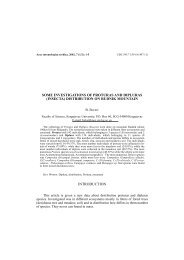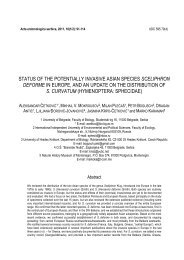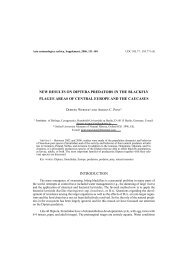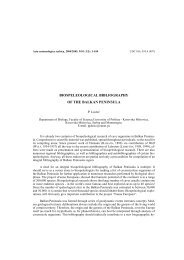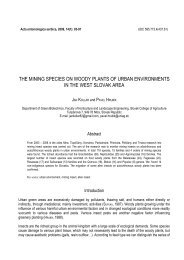checklist of longhorn beetles (coleoptera: cerambycidae)
checklist of longhorn beetles (coleoptera: cerambycidae)
checklist of longhorn beetles (coleoptera: cerambycidae)
You also want an ePaper? Increase the reach of your titles
YUMPU automatically turns print PDFs into web optimized ePapers that Google loves.
Acta entomologica serbica, 2004/2005, 9/10 (1/2): 105-110 UDC 595.768.1 (497.113) (083)<br />
CHECKLIST OF LONGHORN BEETLES (COLEOPTERA:<br />
CERAMBYCIDAE) FROM MT. FRUŠKA GORA<br />
N. PIL<br />
Institute for Nature Conservation <strong>of</strong> Serbia, Radnička 20a,<br />
21000 Novi Sad, Serbia and Montenegro<br />
ABSTRACT: Scientific analysis <strong>of</strong> <strong>longhorn</strong> <strong>beetles</strong> (Coleoptera: Cerambycidae) from references and<br />
material collected on Mt. Fruška Gora during the period 2000 - 2005 has shown the presence <strong>of</strong> 99 species<br />
<strong>of</strong> <strong>longhorn</strong> <strong>beetles</strong> (Coleoptera: Cerambycidae) on Fruška Gora. Among them, four species are recorded<br />
as new for the fauna <strong>of</strong> Serbia and Montenegro, nine species are recorded for the first time for<br />
the Serbian fauna, and six species are new for the fauna <strong>of</strong> Fruška Gora. The list includes some endemic<br />
species and numerous species which are rarely found in Serbia.<br />
KEY WORDS: Cerambycidae, Mt. Fruška Gora.<br />
INTRODUCTION<br />
The Mountain massif <strong>of</strong> Fruška Gora is separated from the rest <strong>of</strong> the Dinarid system. Eurosiberian,<br />
Central and Northern European, Peripannonian, Mediterranean, and in some cases Atlantic<br />
entom<strong>of</strong>aunistic elements can be found in this area.<br />
Several researchers have investigated the entom<strong>of</strong>auna on this in many ways special islandlike<br />
mountain massif surrounded by lowland (ADAMOVIĆ 1950, 1965; MIKŠIĆ 1963; ILIĆ 2005; PIL<br />
and STOJANOVIĆ, in press).<br />
From the 1960’s to the present day, almost no research on this group was done. The given area<br />
is a national park under pressure from logging.<br />
MATERIAL AND METHODS<br />
The <strong>checklist</strong> given in the present paper represents data taken from several published works<br />
(ADAMOVIĆ 1950, 1965; MIKŠIĆ 1963; ILIĆ 2005).
106<br />
N. PIL<br />
Also, some material was collected on field trips to Fruška Gora during the period 2000 - 2005.<br />
This material was identified according to BENSE (1995), while species belonging to the tribe Dorcadionini<br />
were determined according to MIKŠIĆ and KORPIČ (1985).<br />
All results were summarized and analyzed with respect to their distribution (ALTHOFF and<br />
DANILEVSKI, 1997) and bionomy, (whether they are monophagous or polyphagous species).<br />
RESULTS<br />
Recent results show the presence <strong>of</strong> 99 species <strong>of</strong> <strong>longhorn</strong> <strong>beetles</strong> (Coleoptera: Cerambycidae)<br />
on Mt. Fruška Gora (Table 1).<br />
Table 1. Checklist <strong>of</strong> <strong>longhorn</strong> <strong>beetles</strong> (Coleoptera: Cerambycidae) <strong>of</strong> Mt. Fruška Gora with distribution<br />
(Bg - Bulgaria, Ro – Romania, Mc - Macedonia, Gr – Greece, Po – Poland, Cz – Czech<br />
Republic; CE – Central Europe, NE – Northern Europe).<br />
Species<br />
European<br />
D I S T R I B U T I O N<br />
Pontic subregion<br />
Euromedi-terranean<br />
subregion<br />
Euro-siberian<br />
subregion<br />
Aegomorphus clavipes Schrank, 1781 *<br />
Aegomorphus krüperi Kraatz, 1859 *<br />
Agapanthia cardui pannonica Kratochvil, 1985 *<br />
Agapanthia cynerae (Germar, 1817) *<br />
Agapanthia dahli ssp. dahli (Richter, 1821) *<br />
Agapanthia kirbyi Gyllenhal, 1817 *<br />
Agapanthia maculicornis (Gyllenhal, 1817) *<br />
Agapanthia schurmanni (Sama, 1978)<br />
Northern and<br />
Southern European<br />
mountain region<br />
Agapanthia villosoviridescens (Degeer, 1775) *<br />
Agapanthia violacea (Fabricius, 1775) *<br />
Alosterna tabacicolor (Degeer, 1775) *<br />
Anaesthetis testacea Fabricius, 1781 *<br />
Anaglyptus gibbosus (Fabricius, 1787) *<br />
Anaglyptus mysticus (Linnaeus, 1758) *<br />
Anastrangalia dubia (Scopoli, 1763) *<br />
Aromia moschata ssp. moschata (Linnaeus, 1758) *<br />
Brachyleptura scutellata ssp. scutellata (Fabricius, 1781) *<br />
Cerambyx (Mesocerambyx) scopolii (Füsslins, 1775) *<br />
Cerambyx cerdo ssp. cerdo Linnaeus, 1758 *<br />
Cerambyx miles Bonelli, 1823 *<br />
Cerambyx welensii Küster, 1846 *<br />
Chlorophorus aegyptiacus (Fabricius, 1775) * Bg,<br />
Mc, Gr<br />
Chlorophorus figuratus (Scopoli, 1763) *<br />
Chlorophorus hungaricus Seidlitz, 1891 *<br />
Chlorophorus trifasciatus (Fabricius, 1781) *<br />
Chlorophorus varius (Müller, 1766) *<br />
Clytus arietis (Linnaeus, 1758) *<br />
* Gr,<br />
Mc<br />
Palaearctic
Table 1. Continued.<br />
Checklist <strong>of</strong> <strong>longhorn</strong> <strong>beetles</strong> from Mt. Fruška Gora 107<br />
Species<br />
European<br />
D I S T R I B U T I O N<br />
Pontic subregion<br />
Euromedi-terranean<br />
subregion<br />
Euro-siberian<br />
subregion<br />
Northern and<br />
Southern European<br />
mountain region<br />
Clytus rhamni Germar, 1817) *<br />
Cortodera discolor Fairmaire, 1866 *<br />
Cortodera femorata (Fabricius, 1787) *<br />
Corymbia rubra rubra Linnaeus, 1758 *<br />
Dinoptera collaris (Linnaeus, 1758) *<br />
Dorcadion (Carinatodorcadion) aethiops (Scopoli,1763) *<br />
Dorcadion (Carinatodorcadion) fulvum canaliculatum<br />
(Fischer – Waldheim, 1823)<br />
*<br />
Dorcadion (Pedestredorcadion) pedestre ssp. pedestre<br />
(Poda, 1761)<br />
*<br />
Dorcadion (Pedestredorcadion) scopolii (Herbst, 1784) *<br />
Echinocerus floralis (Pallas, 1773) *<br />
Exocentrus adspersus Mulsant, 1846 *<br />
Exocentrus lusitanus (Linnaeus, 1767) *<br />
Grammoptera erythropus Gebler, 1841 *<br />
Po,Cz<br />
Grammoptera ruficornis (Fabricius, 1781) *<br />
Judolia sexmaculata (Linnaeus, 1758) *<br />
NE,CE<br />
Leioderes kollari Redtenbacher, 1849 *<br />
Leptura aurulenta (Fabricius, 1792) *<br />
Lepturalia nigripes (Degeer, 1775) *<br />
NE,CE<br />
Megopis (Aegosoma) scabricornis (Scopoli, 1763) *<br />
Mesosa curculionоides (Linnaeus, 1761) *<br />
Molorchus kiesenwetteri Mulsant & Ray, 1861<br />
Molorchus umbellatarum (Schreber, 1759)<br />
*<br />
Morinus funereus (Mulsant, 1863) *<br />
Necydalis ulmi Chevrolat, 1838 *<br />
Neoclytus acuminatus (Fabricius, 1775) *<br />
Neodorcadion bilineatum (Germar, 1824) *<br />
Obriopsis bicolor Kraatz, 1862 *<br />
Oplosia fennica (Paykull, 1800) *<br />
Pachyta quadrimaculata ( Linnaeus, 1758) *<br />
Pachytodes cerambyciformis (Schrank, 1781) *<br />
Pachytodes erraticus (Dalman, 1817) *<br />
Phymatodellus rufipes (Fabricius, 1776) *<br />
Phymatodes testaceus (Linnaeus, 1758) *<br />
Phytoecia coerulescens (Scopoli, 1763) *<br />
Phytoecia hirsutula (Frölich, 1793) *<br />
Phytoecia icterica (Schaller, 1783) *<br />
Phytoecia molybdaena (Dalman, 1817) *<br />
Phytoecia pustulata pustulata (Schrank, 1776) *<br />
Phytoecia scutellata (Fabricius, 1792) *<br />
Phytoecia uncinata (Redtenbacher, 1842) * CE<br />
Phytoecia virgula (Charpentier, 1825) *<br />
Plagionotus arcuatus (Linnaeus, 1758) *<br />
Palaearctic
108<br />
Table 1. Continued.<br />
Species<br />
N. PIL<br />
D I S T R I B U T I O N<br />
DISCUSSION AND CONCLUSIONS<br />
Those 99 cerambycid species belong taxonomically to six subfamilies and 25 tribes. This is<br />
39.6 % <strong>of</strong> the total number <strong>of</strong> known species in Serbia.<br />
Distribution analysis revealed the presence <strong>of</strong> inhabiting the Euromediterranean (42%), Eurosiberian<br />
(30%), and Pontic subregions (12%).<br />
European<br />
Pontic subregion<br />
Euromedi-terranean<br />
subregion<br />
Euro-siberian<br />
subregion<br />
Northern and<br />
Southern European<br />
mountain region<br />
Plagionotus detritus (Linneaus, 1758) *<br />
Plagionotus floralis (Pallas, 1773) *<br />
Pogonocherus hispidus (Linnaeus, 1758) *<br />
Prionus coriarius (Linnaeus, 1758) *<br />
Pseudovadonia livida (Fabricius, 1776) *<br />
Purpuricenus budensis (Götz, 1783) *<br />
Rhagium (Megarhagium) sycophanta (Schrank, 1781) *<br />
Rhagium mordax (De Geer, 1775) *<br />
Ropalopus clavipes (Fabricius, 1775) *<br />
Ropalopus macropus (Germar, 1824) *<br />
Rosalia alpina (Linnaeus, 1758) *<br />
Rutpela maculata (Poda, 1761) *<br />
Saperda octopunctata (Scopoli, 1792) *<br />
Spondylis buprestoides (Linnaeus, 1758) *<br />
Stenocorus quercus (Goetz, 1783) *<br />
Stenopterus ater (Linnaeus, 1767) *<br />
Stenopterus flavicornis Küster, 1846 *<br />
Stenopterus rufus geniculatus Kraatz, 1863 *<br />
Stenopterus similatus Holzschuh, 1979 * Gr<br />
Stenosola dubia (Laicharting, 1784) * CE<br />
Stenostola ferrea (Schrank, 1776) *<br />
NE,CE<br />
Stenurella bifasciata (Müller, 1776) *<br />
Stenurella melanura var corvina (Linnaeus, 1758) *<br />
Stenurella nigra (Linnaeus, 1758) *<br />
Stenurella septempunctata (Fabricius, 1792) *<br />
Strangalia attenuata (Linnaeus, 1758) *<br />
Tetropium fuscum (Fabricius, 1787) *<br />
Tetrops praeusta (Linnaeus, 1758) *<br />
Vadonia hirsuta (Daniel et Daniel,1891) * Ro<br />
Vadonia steveni (Sperk, 1835) *<br />
Vadonia unipunctata ssp. unipunctata (Fabricius, 1787) *<br />
Xylotrechus antilope (Schönherr, 1817) *<br />
T O T A L : 9 12 42 30 2 4<br />
Palaearctic
Checklist <strong>of</strong> <strong>longhorn</strong> <strong>beetles</strong> from Mt. Fruška Gora 109<br />
Among them, the following four species are recorded as new for the fauna <strong>of</strong> Serbia and<br />
Montenegro: Cortodera discolor Fairmaire, 1866; Stenopterus similatus Holzschuh, 1979; Chlorophorus<br />
aegyptiacus (Fabricius, 1775); and Agapanthia osmanlis Reiche, 1858.<br />
Nine species are recorded for the first time for the Serbian fauna: Agapanthia maculicornis<br />
(Gyllenhal, 1817); Lepturalia nigripes (Degeer, 1775); Cortodera femorata (Fabricius, 1787); Vadonia<br />
hirsuta (Daniel and Daniel, 1891); Anaglyptus gibbosus (Fabricius, 1787); Agapanthia<br />
schurmanni Sama, 1978; Grammoptera erythropus Gebler, 1841; Judolia sexmaculata (Linnaeus,<br />
1758); and Obriopsis bicolor Kraatz, 1862.<br />
Six species were new for the fauna <strong>of</strong> Mt. Fruška Gora: Phytoecia molybdaena (Dalman,<br />
1817); Stenostola ferrea (Schrank, 1776); Ropalopus clavipes (Fabricius, 1775); Ropalopus macropus<br />
(Germar, 1824); Agapanthia cynerae (Germar, 1817); and Vadonia steveni (Sperk, 1835).<br />
Also noticed was the presence <strong>of</strong> some endemic species, predominantly Balkan endemics: Vadonia<br />
hirsuta (Daniel and Daniel, 1891); Phytoecia hirsutula (Frölich, 1793); Cortodera discolor<br />
Fairmaire, 1866, Chlorophorus aegyptiacus (Fabricius, 1775); Agapanthia schurmanni Sama,<br />
1978; and Aegomorphus krüperi Kraatz, 1859. Some <strong>of</strong> them were previosly registered at only on<br />
one locality or in only one Balkan country, for example Vadonia hirsuta (Daniel and Daniel, 1891)<br />
in Romania (Dobruja region) or Stenopterus similatus Holzschuh, 1979 in Greece.<br />
There are numerous species which are rarely found in Serbia, apart from those mentioned earlier<br />
as new and endemic species: Vadonia steveni (Sperk, 1835); Tetropium fuscum (Fabricius,<br />
1787); Stenostola ferrea (Schrank, 1776); Stenosola dubia (Laicharting, 1784); Stenopterus ater<br />
(Linnaeus, 1767); Stenocorus quercus (Goetz, 1783); Pogonocherus hispidus (Linnaeus, 1758);<br />
Phytoecia uncinata (Redtenbacher, 1842); Phytoecia scutellata (Fabricius, 1792); Phytoecia molybdaena<br />
(Dalman, 1817); Oplosia fennica (Paykull, 1800); Obriopsis bicolor Kraatz, 1862, Necydalis<br />
ulmi Chevrolat, 1838; Molorchus umbellatarum (Schreber, 1759); Molorchus kiesenwetteri<br />
Mulsant and Ray, 1861; Exocentrus lusitanus (Linnaeus, 1767); Chlorophorus trifasciatus (Fabricius,<br />
1781); Chlorophorus hungaricus Seidlitz, 1891; Cerambyx welensii Küster, 1846; Anaesthetis<br />
testacea Fabricius, 1781; Agapanthia schurmanni (Sama, 1978); Agapanthia maculicornis (Gyllenhal,<br />
1817); Agapanthia cynerae (Germar, 1817) (second record for Serbia); Aegomorphus krüperi<br />
Kraatz, 1859; and Aegomorphus clavipes Schrank, 1781.<br />
No rare or endemic species were noted in ADAMOVIĆ (1950, 1965) or MIKŠIĆ (1963).<br />
REFERENCES<br />
ADAMOVIĆ, Ž., 1950. Zbirka Cerambycidae u Prirodnjačkom muzeju srpske zemlje. I deo. Naučna<br />
knjiga, Beograd.<br />
ADAMOVIĆ, Ž., 1965, Cerambycidae (Coleoptera) collected in Serbija. Glasnik Prirodnjačkog muzeja<br />
srpske zemlje, Beograd, B. XX, 147-183.<br />
ALTHOFF, J. & M.L. DANILEVSKI, 1997. A <strong>checklist</strong> <strong>of</strong> longicorn <strong>beetles</strong> (Coleoptera, Cerambycoidea)<br />
<strong>of</strong> Europe. Slovensko entomološko društvo Štefana Michielija, Ljubljana.
110<br />
N. PIL<br />
BENSE, U., 1995. Bockkäfer: Illustrierter Schlüsel zu den Ceramyciden und Vesperiden Europas<br />
(Longhorn <strong>beetles</strong>), Margraf Verlag, Weikerscheim.<br />
ILIĆ, N., 2005. Strižibube Srbije (Coleoptera, Cerambycidae) – Faunistički pregled. SZGR “Joksimović”,<br />
Beograd, 1-180.<br />
MIKŠIĆ, R., 1963. Beitrag zur Kenntnis der Bockkäferfauna (Cerambycidae) slaviens. Acta biol.,<br />
Zagreb, 3 :55-188.<br />
MIKŠIĆ, R., 1971. Katalog der Bockkäfer (Cerambycidae) Jugoslawiens. Institut za Šumarstvo,<br />
Sarajevo.<br />
MIKŠIĆ, R. & E. GEORGIJEVIĆ, 1971. Cerambycidae <strong>of</strong> Yugoslavia, part I. Akad. nauka i umetnosti<br />
Bosne i Hercegovine, Sarajevo, XLIII, 3: 1-175. [in Serbian]<br />
MIKŠIĆ, R. & E. GEORGIJEVIĆ, 1973. Cerambycidae <strong>of</strong> Yugoslavia, part II. Akad. nauka i umetnosti<br />
Bosne i Hercegovine, Sarajevo, XLV, 4:1-153. [in Serbian]<br />
MIKŠIĆ, R. & M. KORPIČ, 1985. Cerambycidae <strong>of</strong> Yugoslavia, part III. Akad. nauka i umetnosti Bosne<br />
i Hercegovine, Sarajevo, LXII, 5: 1-148. [in Serbian]<br />
PIL, N. & D. STOJANOVIĆ, 2005. New <strong>longhorn</strong> <strong>beetles</strong> (Coleoptera: Cerambycidae) from the Union<br />
<strong>of</strong> Serbia and Montenegro. Arch. Biol. Sci., Belgrade. [in press]<br />
СПИСАК РЕГИСТРОВАНИХ ВРСТА СТРИЖИБУБА (COLEOPTERA:<br />
CERAMBYCIDAE) НА ФРУШКОЈ ГОРИ<br />
Н. ПИЛ<br />
Завод за заштиту природе, Радничка 20а, 21000 Нови Сад, Србија и Црна Гора<br />
Обједињавањем детаљних литературних података (ADAMOVIĆ (1950, 1965), MIKŠIĆ<br />
(1963), ILIĆ (2005)) о фауни стрижибуба (Coleoptera: Cerambycidae) на Фрушкој гори, као и<br />
детерминисаних врста сакупљених током 2000 – 2005. године добијен је јединствен списак<br />
од 99 врста, што чини 39.6% од укупног броја до данас регистрованих врста у Србији. У ту<br />
коначну бројку сабрали смо и нове врсте што за СЦГ што само за Србију да би добили тачан<br />
однос.<br />
Анализа фаунистичке припадности показала је највећу бројност еуромедитеранских<br />
врста (42%), затим еуросибирских (30%), и на крају понтијских врста (12%).<br />
На овом списку нашле су се: - 4 врсте нове за фауну СЦГ, - 9 врста нових за фауну Србије,<br />
- 6 врста до сада нерегистрованих на Фрушкој гори, - 6 балканских ендема, - 25 ретких<br />
врста.<br />
Accepted September 28, 2005



